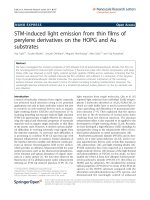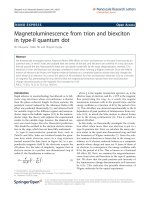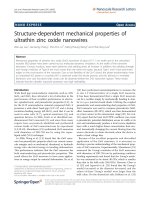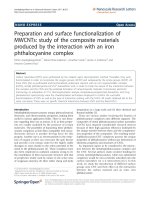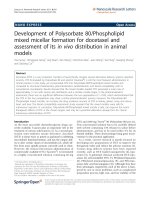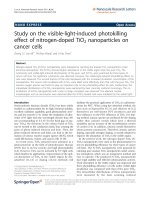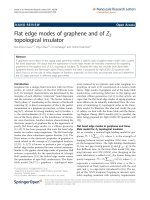Kang et al. Nanoscale Research Letters 2011, 6:363 pptx
Bạn đang xem bản rút gọn của tài liệu. Xem và tải ngay bản đầy đủ của tài liệu tại đây (1.74 MB, 10 trang )
NANO EXPRESS Open Access
Design process of the nanofluid injection
mechanism in nuclear power plants
Myoung-suk Kang
1
, Changhyun Jee
1
, Sangjun Park
1
, In Choel Bang
2
and Gyunyoung Heo
1*
Abstract
Nanofluids, which are engineered suspensions of nanoparticles in a solvent such as water, have been found to
show enhanced coolant properties such as higher critical heat flux and surface wettability at modest
concentrations, which is a useful characteristic in nuclear power plants (NPPs). This study attempted to provide an
example of engineering applications in NPPs using nanofluid technology. From these motivations, the conceptual
designs of the em ergency core cooling systems (ECCSs) assisted by nanofluid injection mechanism were proposed
after following a design framework to develop complex engineering systems. We focused on the analysis of
functional requirements for integrating the conventional ECCSs and nanofluid injection mechanism without loss of
performance and reliability. Three candidates of nanofluid-engineered ECCS proposed in previous researches were
investigated by applying axiomatic design (AD) in the manner of reverse engineering and it enabled to identify
the compatibility of functional requirements and potential design vulnerabilities. The methods to enhance such
vulnerabilities were referred from TRIZ and concretized for the ECCS of the Korean nuclear power plant. The results
show a method to decouple the ECCS designs with the installation of a separate nanofluids injection tank adjacent
to the safety inje ction tanks such that a low pH environment for nanofluid s can be maintained at atmospheric
pressure which is favorable for their injection in passive manner.
Introduction
One of the methods for enhancing the safety of nuclear
power plants (NPPs) is related to improve their heat
transfer capability. Nanofluids are known to exhibit
superior heat transferability and are therefore being
actively investigated for engineering applications [1-4].
Recently, the studies on the introduction of nanofluids
for emergency core cooling systems (ECCSs) which is
one of engineered safety features of NPPs were con-
ducted [5-7]. Such works were characterized by the
enhancement of critical heat flux (CHF) via nanofluid
injection in cases of loss of coolant accidents (LOCAs).
While taking the benefits of nanofluid injection during
accident conditions, i t is a pparent that the nanofluid-
engineered ECCSs should be compatible with conven-
tional systems during normal operations to make nano-
fluid technologies practical in NPPs. With this
motivation, it is, therefore, important to analyze the
functional requirements (FRs) for integrating the ECCS
and nanofluid injection mechanism without loss of per-
formance and reliability of the conventional systems.
This study employs axiomatic design (AD) and TRIZ
for analysis of FRs and creation of a relevant nanofluid-
engineered ECCS. The theory underlying AD is based
on the hypothesis that superior design b egins with cer-
tain axioms that facilitate the creation of systems
through interactive mapping of FRs and design para-
meters (DPs). In addition, AD facilitates reasonable and
logical steps that take conceptual design processes into
account [8,9]. The second tool employed in this study
TRIZ, which is a Romanized acronym of a Russian
phrase meaning, ‘theory of solving inventor’sproblems’
or ‘theory of inventive problem solving ’ [10]. The TRIZ
theory applies abstraction and concretization processes
to facilitate the creation of solutions for problems recog-
nized from an existing design by the AD process [11].
In this study, the analysis of a conventional design of
an ECCS and several design alternatives to adopt nano-
fluid injection mechanism using the principles of AD
has been presented, and also the compatibility of FRs
and potential design vulnerabilities are discussed. The
methods to enhance such vulne rabilities are drawn from
* Correspondence:
1
Kyung Hee University, 1 Seocheon-dong, Giheung-gu, Yongin-si, Gyeonggi-
do 446-701, Republic of Korea
Full list of author information is available at the end of the article
Kang et al. Nanoscale Research Letters 2011, 6:363
/>© 2011 Kang et al; licensee Springer. This is an Open Access article distributed under the terms of the Creative Commons Attribution
License (http:/ /creativecommons.org/licenses /by/2.0), which permits unrestricted u se, distribution, and reproduction in any medium,
provided the origina l work is properly cited.
TRIZ and finally concretized a specific design of a nano-
fluid-engineered ECCS. In this article, a conceptual
design incorporating nanofluids for the ECCSs of the
Korean Advanced Power Reactor 1400MWe (APR1400)
has been elicited.
Background
LOCA and ECCS
A LOCA is an accident which occurs due to a break in
a reactor coolant system (RCS) pipeline in a NPP.
LOCAs are considered to be serious accidents because
of the possibility of core meltdown. As the reactor cool-
ant drains out of the RCS, the temperatures of the
nuclear fuel rods increase due to the lack of coolant.
Core meltdown may result from the increased tempera-
tures of the fuel rods.
An ECCS is one of the engineered safety features and
supplies sufficient coolants to a core for maintaining fuel
temperatures below its melting point and therefore core
meltdown could be avoided in case of a LOCA. An ECCS
consists of a safety injection system (SIS) and a shutdown
cooling system (SCS). The purpose of the SIS is core heat
removal and power decrease via borated water injection
following a LOCA. In the APR1400, emergency coolant
is inje cted from safety inje ction tanks (SITs) and via
safety injection pumps (SIPs) from an in-containment
refueling wat er storage tank (IRW ST). The SCS is
designed to provide residual heat removal in shutdown
situations, which is a long term operation mode [12]
Nanofluids
Nanofluids are engineered colloidal dispersions with a
traditional coolant as a base in which nanoparticles are
suspended. In 1995, Choi, who first named nanofluids,
published the results of his theoretica l research. Subse-
que nt developments in nanofluid engineering have con-
tributed to the rapid growth in nanotechnology and
surface technologies over the last 10 years [2].
The colloidal suspensions have substantially shown
intriguing thermal performances regarding four points:
(1) increased thermal conductivity (approx. 150%), (2)
increased single-phase heat transfer coefficient (approx.
60%), (3) increased critical heat flux with extended
nucleate boiling regime (approx. 200%), and (4)
improved quenching efficiency. Although there is a lack
of agreement of the experimental data in the literature
and a lack of understanding of the physical mechanisms
describing nanofluid thermal performances, the present
work was motivated by the fact that a nanofluid formu-
lation could not be tailor ed to show the desired proper-
ties for nuclear systems if we do not consider it together
with nuclear safety systems characterized inherently by
various couplings in a system engineering [13]. These
properties were expected to be b etter especially when
nanofluids are employed as coolants in ECCSs, and sev-
eral applications to light water reactors have been pub-
lished [4-7]. The design alternatives suggested in
previous studies can be summarized as follows:
OPTION 1: injection of nanofluids from conventional
SITs
OPTION 2: installation of a nanofluids-engineered
SIT which is dedicated for nanoparticle injection
OPTION 3: injection of nanofluids via IRWST lines
Axiomatic design and TRIZ
The purpose of AD is to create the improved design of
various tangible and intangible products. It provides an
objective means for evaluating competing designs and
enabling a better design to be chosen. The following
two axioms are expressions that integrate common prin-
ciples mapping FRs and DPs [9]:
Axiom 1: Independence Axiom. Maintain the indepen-
dence of the FRs.
Axiom 2: Information Axiom. Minimize the informa-
tion content of the design.
The mapping process between two domains can also
be represented mathematically in terms of characteristic
vectors that define the design goals or FRs and design
solutions or DPs:
{
FR
}
=
[
A
]
{
DP
}
where [A] is the design matrix.
In order to satisfy axiom 1, [A] must be either diagonal
or triangular. In the case where [A] is diagonal, each of the
FRs can be satisfied independently by one of the DPs. This
situation is called an uncoupled design. In the case where
[A] is triangular, the independence of the FRs can be satis-
fied by determining the DPs in the proper sequence. This
is called a dec oupled desi gn. In thi s case, [A] does not
necessarily have to be triangular in strict sens e. A design
corresponding to any other form of the design matrix is
said to be coupled. Consequently, a diagonal or triangular
design matrix gives rise to a better design. In practice,
however, most designs are coupled, so that designers must
decouple the object design by intelligently selecti ng rele-
vant DPs, which can be referred as an improved design.
Finally, axiom 2 can be used for determining the best solu-
tion among the decoupled or uncoupled design options.
Following the AD process, design ers may encounter a
problem about how to obtain a decoupled solution or
convert a coupled design into decoupled. TRIZ is one of
the tools to give a reasonable approach to find such a
solution. TRIZ is a knowledge-based methodology for
facilitating problem-solving in the context of invention.
Specifically, by utilizing problem-solving elements from
Kang et al. Nanoscale Research Letters 2011, 6:363
/>Page 2 of 10
prominent inventions, one can solve one’ sown
problems or produce further innovations with less effort.
TRIZ is based on a hypothesis that patterns or analogi-
cal concepts leading to exceptionally innovative solu-
tions to technical problems can be extracted through
analysis of past inventi ons. In support of the hypothesis,
an enormous number of patents have been researched
and still being analyzed [10].
The most significant benefit of using TRIZ in AD pro-
cess is identification and consequently removal of tech-
nical contradiction (which is the interchangeable term
as coupling in AD process) with the help of certain
principles. It should be noted that decoupling a design
in terms of AD is similar to removing a technical con-
tradicti on in TRIZ. In a design process, the principles of
AD do not practically provide a guarantee d method to
determine the proper DPs. However, all of the TRIZ
principles focus on methods to exclude technical contra-
dictions within not only all branches of engineering, but
also non- tech nical fields as well. Figure 1 shows how to
apply TRIZ in AD to a problem.
The coupling recognized in AD is equivalently asso-
ciated with a contradictionwithTRIZ.Tocreatethe
DPs to decouple the design matrix, designers should
represent their specific problems with typical language.
This process, called ‘abstractization’,isthefirststepfor
applying the TRIZ on the results of AD process. Utiliz-
ing the TRIZ principles for abstractized problems or
contradictions helps designers obtain general solutions
which are the ideas to remove the technical contradic-
tions by changing the physical parameters such as geo-
metrical shapes, physical conditions, matter states, and
so on. Since the general solutions are not directly
applic able to the specific problems, mostly designers are
required to concretize the general solutions for the spe-
cific solutions concerning the characteristics of the ori-
ginal problems [14,15].
Design process an d results
The design process was started from the reverse engi-
neering of c onventional ECCS and n anofluids injection
mechanisms using the principles of AD followed by
identification of design weaknesses in terms of cou-
plings. These design weaknesses was then eliminat ed by
virtue of TRIZ, and finally a specific design was created.
Reverse engineering of conventional ECCSs
We investigated the FRs of the ECCS of the APR1400 to
employ a nanofluid injection mechanism. Three nano-
fluid injection mechanisms were referred from previous
studies [5-7]. The FR and DP decomposition starts at
the top requirement of the ECCS as follows [14,15]:
FR0: shut down a reactor while preventing core melt
after LOCA
DP0: nanofluid-engineered ECCS
The sub-FRs of DP0 are the requirements to inject
coolant during the initial phase (FR1) and to prov ide
long-term cooling (FR2). The respective DPs of FR1 and
FR2 constitute the SIS and SCS as follows:
FR1: injection of coolant at the beginning of LOCA
DP1: safety injection system
FR2: provides long-term cooling for reactor cold
shutdown
DP2: shutdown cooling system
FR1 should be related to the reflooding and refilling
stage. The corresponding DP1 is primarily associated
with all options. With regard to option 1, FR1.1, FR1.2,
and FR1.3 are as follows:
Figure 1 Problem-solving using TRIZ in AD process.
Kang et al. Nanoscale Research Letters 2011, 6:363
/>Page 3 of 10
FR1.1: provides coolant from conventional SITs
DP1.1: injection of borated water from conventional
SITs
FR1.2: provides nanoparticles
DP1.2: [Option 1] injection of nanofluids from con-
ventional SITs as nanoparticles mixed with borated
water
FR1.3: provides coolant from a conventional IRWST
DP1.3: injection of borated water from conventional
IRWST
We can define the sub-requirements of DP1.1 again as
follows.
FR1.1.1: provides sufficient coolant inventory
DP1.1.1: conventional SITs
FR1.1.2: provides a driving force for coolant
DP1.1.2: pressurized nitrogen
FR1.1.3: provides a control signal for coolant
DP1.1.3: passive actuation
FR1.1.4: provides a flow path for coolant
DP1.1.4: valve arrangement
A sub-FR of DP1.2, ‘injection of nanofluids from con-
ventional SITs as nanoparticles mixed with borated
water’ is required to provide a sufficient quantity of
nanoparticles, stability of the nanoparticles, convenient
nanoparticle sampling, compatibility with tanks, struc-
tures for na noparticle storage, and contin uous mixing
with borated water. They may be summarized is as
follows:
FR1.2.1: provides a sufficient quantity of nanoparticles
DP1.2.1: volume percentages of nanoparticles
FR1.2.2: provides continuous stability of nanoparticles
DP1.2.2: pH stabilizer (acidic condition)
FR1.2.3: provides a check for nanoparticle stability
DP1.2.3: sampling device
FR1.2.4: provides compatibility for corrosion resistance
DP1.2.4: neutral pH stabilizer
FR1.2.5: provides storage for nanoparticles
DP1.2.5: conventional SIT
FR1.2.6: mixes the nanoparticles and coolant
DP1.2.6: preloaded nanoparticles into a conventional
SIT
WecompletedthesetofFRsandDPsandFigure2
shows the entire design matrix for option 1 . The boxes
marked in Figure 2 i ndicate that the functional cou-
plings or technical contradictions. There are two impor-
tant couplings identified due to the share of the
conventional SIT as a reservoir of coolant and nano-
fluid:
FR1.1.2
FR1.2.3
=
XX
XX
DP1.1.2
DP1.2.3
where FR1.1.2 provides a driving force for the nano-
particles, FR1.2.3 provides a check for nanoparticle
stability, andDP1.1.2 pressurized nitrogen, DP1.2.3 sam-
pling device.
Thi s is the first contradiction caused by nitrogen pre-
pressurization and nanofluid sampling. The sampling for
checking the stability of nanoparticles requires depres-
surization of the contents of the SIT. However, the
depressurization of the SIT does not contribute to a
driving force for the coolant and nanoparticles.
FR1.2.2
FR1.2.4
=
XX
XX
DP1.2.2
DP1.2.4
where FR1.2.2 provides stability of nanoparticles,
FR1.2.4 provides compatibility for corrosion resis-
tance, DP1.2.2 pH stabilizer (acidic condition), and
DP1.2.4 neutral pH stabilizer.
The original option 1 does not mention any metho ds
to control corrosion caused by nanofluids. To ensure
homogeneity of the nanoparticles in the SIT, the pH
state of the SIT should be acidic. However, acidic con-
tents can induce corrosion of the SIT. Consequently,
the FRs and DPs which satisfy each of these functions
contradict one another.
Using the same method, option 2 was then analyzed.
Identifying the FRs and DPs for option 2 is similar to
the process for option 1 except the facts that option 2
uses a separat ed nanofluid injection tank and the tank
has titanium coating due to the corrosion of the tank
wall. Since the size of the nanofluid injection tank is
much smaller than the SITs, the wall coating is reason-
able in terms of cost.
FR1.1: provides borated water
DP1.1: conventional SITs
FR1.2: provides nanoparticles
DP1.2: [Option 2] a nanofluid engineered SIT which is
dedicated for nanoparticle injection
FR1.3: provides coolant from a conventional IRWST
DP1.3: injection of borated water from a conventional
IRWST
Figure 3 shows the coupling in designing option 2.
The coupling in option 2 is identical to the first cou-
pling of option 1 since it also needs nitrogen pre-pres-
surization and nanofluid sampling.
Option 3 is the nanoparticle injection method con-
nected with the IRWST. It provides the nanoparticles in
a separate tank with coolant from the IRWST in a
mixed state by the SIP. Figure 4 shows the resulting
design matrix for option 3.
In option 3, any significant couplings do not exist due
to a separate reservoir for nanofluid and an active driv-
ing force such as SIPs.
Kang et al. Nanoscale Research Letters 2011, 6:363
/>Page 4 of 10
Considerations for constraints
In order to finalize a design process, we should consider
design constraints, for example, i njection time, reliabil-
ity, installation space, and cost for nanofluid-engineered
ECCSs. The constraints belong to a detailed design pro-
cess so it is not easy to estimate them quantitatively at
this moment. We discuss the overall aspects of con-
straints on the basis of the analyzed FRs.
First, nanoparticles should be promptly injected into the
core. From this viewpoint, options 1 and 2 are preferable
because the SITs can be activated at an early stage of
LOCAs. Option 3 may contribute to coolability at later
stage. On the other hand, options 1 and 2 do not further
provide nanofluids after the refill stage. Option 3 can pro-
vide a continuous nanofluid via a flow rate control device
connected to the IRWST. Second , nanoparticles must be
provided re liably in any types of injection mechanism.
Option 1 can be regarded as the best fr om the viewpo int
of risk due to its passive characteristic. Option 2 and 3
may need additional devices to isolate and pass the
Figure 2 Design matrix for option 1 (dash: coupling 1, solid: coupling 2).
Kang et al. Nanoscale Research Letters 2011, 6:363
/>Page 5 of 10
nanofluids in the tank in an appropriate manner, so
reliability may be less than optio n 1. Third, option 1
does not require any additional space in the contain-
ment for installation as discussed. In practice, a large
space may not be required for installation of a nano-
particle injection tank for optio n 2 and 3 because the
volume of nanofluids is much smaller than that of
emergency coolant. From the viewpoint of cost,
installation space, additional manufacturing, mainte-
nance may be associated. Since option 2 and 3 equips
separate devices, it is likely to need higher cost.
Design modification
In this section, we reformed conventional nanoparticle
injection mechanisms using T RIZ. First, we focused on
the coupling discussed for o ption 1 and 2. For the first
Figure 3 Design matrix for option 2.
Kang et al. Nanoscale Research Letters 2011, 6:363
/>Page 6 of 10
coupling, consisting of the FRs ‘provide a d riving force
for the nanopartic les’ and ‘provide a check of nanoparti-
cles stability’ and the DP ‘ pressurized nitrogen’ and
‘sampling device’, we abstractized the technical contra-
diction as ‘pre-pressurization, but depressurization’ .
Then, we applied the principles of TRIZ to find the gen-
eral solution of the technical contradiction with a con-
tradiction matrix system. This matrix provides selective
options for ‘Features to improve’ and ‘Undesired results’.
We applied our technical contradiction to this matrix by
the feature to improve, ‘the difficulty of detection and
measur ement’ and th e undesired result, ‘the Shape’.The
result of this matrix is summarized in Table 1.
We took the third and fourth principles in this case,
though all principles in the results can be all owable.
Considering the third principles, the conventional SITs
and nanofluid injection tank should be separated. Then,
by the fourth principle, SITs should be pressurized and
the nanofluid injection tank should keep depressurized
but can pressurize depending on conditions. At this
time, the second coupling in option 1 was simulta-
neously resolved by adopting a titanium coating tank for
nanofluids, which is the same method for option 2.
Finally we concretized a nanofluid-engineered ECCS with
a separate nanofluid injection tank as shown in Figure 5.
The developed nanofluid-engineered ECCS consists of
a borated water storage and a nanofluid storage. The
borated water storage tank, which is the conventional
SIT, can sustain a pressure of over 40 bars. On the
other hand, the nanofluid storage tank can maintain its
Figure 4 Design matrix for option 3.
Kang et al. Nanoscale Research Letters 2011, 6:363
/>Page 7 of 10
contents at atmospheric pressure, while also maintaining
them at a stable low pH with a titanium coating on the
inner surface of the tank, which is required to tackle the
nanoparticle stability problem.
As shown in Figure 5, during normal operation, the
borated water and nanofluids are separated by an isola-
tion stopper connected to a floater inside the SIT. This
isolation stopper is placed at the inner surface of the
SIT by pressurized nitrogen and the floater with sealing
the pipe line connecting the SIT and nanofluids injec-
tion tank. Following a LOCA, the pressure inside the
RCS decreases below the pressure of the SITs, at which
point emergency coolant is injected into the RCS. At
this moment, the gravitational force generated by the
Table 1 Inventive principles in terms of the first coupling
Inventive
principles
Description of inventive principles
1. Cheap short-
living
Replace an expensive object with a multitude of
inexpensive objects, compromising certain qualities
2. The other way
around
Invert the action used to solve a problem. For
example, instead of cooling an object, heat it.
Make the movable parts fixed, and the fixed parts
movable
Turn the object ‘upside down’
3. Segmentation Subdivide an object into parts
Make an object easy to disassemble
Increase the degree of fragmentation of an object
4. Inert
atmosphere
Replace a normal environment with an inert one
Add neutral parts, or inert additives to an object
Figure 5 Schematic diagram of nanofluid-engineered SIT (out of scale).
Kang et al. Nanoscale Research Letters 2011, 6:363
/>Page 8 of 10
floater opens the isolation stopper. Finally, the pressu r-
ized nitrogen forces the nanofluids, mixed with coolant
from the SITs, to be injected. The decoupled matrix
resulting from this design is as follows:
FR1.1.2
FR1.2.3
=
XO
OX
DP1.1.2
DP1.2.3
where FR1.1.2 provides a driving force for the nano-
particles, FR1.2.3 provides a check for nanoparticle sta-
bility, DP1.1.2 pressurizednitrogen,andDP1.2.3
sampling device.
FR1.2.2
FR1.2.4
=
XO
OX
DP1.2.2
DP1.2.4
where FR1.2.2 provides stab ility to the nanopart icles,
FR1.2.4 provides compatibility for corrosion resistance,
DP1.2.2 pH stabilizer (acidic condition), and DP1.2.4 coat-
ing of anti-corrosion material in nanoparticle storage tank.
From the design matrix, the sampling device of the
new system is no longer disturbed by pressurized nitro-
gen. Likewise, acidic condition of coolant will not harm
to the tank anymore.
Conclusions
The history of nuclear industries should be the same
as the history of nuclear safety. All activities from
design to maintenance of NP Ps are associated with
safety. Even though the benefit of nanofluids is appar-
ent in terms of heat transfer capability, its application
should be considerate. It should be noted that both
experience and theory have shown that the conceptual
design stage is the most important for system’sperfor-
mance as well as safety, particularly in complex sys-
tems. Therefore, this study was performed to motivate
and accelerate the use of nanofluid technologies in the
practical applications.
The new method of nanofluids injection under
LOCAs was proposed in this paper with analyzing the
FRs of the candidates suggested in the previous
researches on the basis of the principles of AD and
TRIZ tools. Following the analysis of conventional ideas,
major couplings were recognized. To solve these kinds
of couplings, the installation of a separate nanofluids
injection tank adjacent to the SITs was proposed. This
tank is connected to the SIT with a passive gravity-oper-
ated stopper. The interior of the nanofluids injection
tank is titanium-coated to permit a low pH environ-
ment. Depending on the detailed design processes, some
of DPs may be revised or replaced, but this paper will
contributed on the development of the preliminary steps
connecting a scientific phase and an engineering phase.
Abbreviations
AD: axiomatic design; CHF: critical heat flux; DPs: design parameters; ECCSs:
emergency core cooling systems; FRs: functional requirements; IRWST: in-
containment refueling water storage tank; LOCAs: loss of coolant accidents;
NPPs: nuclear power plants; RCS: reactor coolant system; SCS: shutdown
cooling system; SIS: safety injection system; SIPs: safety injection pumps; SITs:
safety injection tanks.
Acknowledgements
This research was supported by Basic Science Research Program through the
National Research Foundation of Korea (NRF) funded by the Ministry of
Education, Science and Technology (2009-0069122).
Author details
1
Kyung Hee University, 1 Seocheon-dong, Giheung-gu, Yongin-si, Gyeonggi-
do 446-701, Republic of Korea
2
Ulsan National Institute of Science and
Technology, 100 Banyeon-ri, Eonyang-eup, Ulju-gun, Ulsan-si 689-798,
Republic of Korea
Authors’ contributions
MK participated in the reverse engineering and drafted the manuscript. CJ
performed the design modification and participated in the reverse
engineering. SP performed the precedent analysis and participated in the
reverse engineering. IB provided the properties of nanofluids. GH conceived
of the study, and participated in its design and coordination. All authors
read and approved the final manuscript.
Competing interests
The authors declare that they have no competing interests.
Received: 8 December 2010 Accepted: 27 April 2011
Published: 27 April 2011
References
1. Choi SUS: Enhancing thermal conductivity of fluids with nanoparticles.
Developments and Applications of Non-Newtonian Flows New York: ASME;
1995, 99-105, FED-Vol.23
2. Kim HD, Dewitt G, Mckrell T, Buongiorno J, Hu L: On the quenching of
steel and zircaloy spheres in water-based nanofluids with alumina, silica
and diamond nanoparticles. Int J Multiphase Flow 2009, 35:427-438.
3. Kim SJ: Pool boiling heat transfer characteristics of nanofluids. PhD thesis
Massachusetts Institute of Technology; 2007.
4. Chupin A, Hu LW, Buongiorno J: Applications of nanofluids to enhance
LWR accidents management in in-vessel retention and emergency core
cooling systems. Proceedings of International Congress on Advances in
Nuclear Power Plants 2008 Anaheim, California; 2008.
5. Pop MGM, Brian GL: Nuclear power plant using nanoparticles in emergency
systems and related method. 2008, U.S. Patent: US 2008/0212733A1.
6. Pop MGM, Brian GL, Angelo B: Nuclear power plant using nanoparticles in
emergency situations and related method. 2008, U.S. Patent: US 2008/
0219395A1.
7. Pop MGM, Brian GL: Nuclear power plant using nanoparticles in closed
circuit of energency systems and related method. 2008, U.S. Patent US
2008/029396A1.
8. Suh NP, Bell AC, Gossard DC: On an axiomatic approach to
manufacturing, manufacturing systems. J Eng Ind 1978, 100:127-130.
9. Suh NP: Axiomatic design: Advances and Applications Oxford: Oxford
University Press; 2010.
10. Alshuller G, Shulyak L, Fedoseev U: 40 Principles TRIZ Key to Technical
Innovation Worcester: Technical Innovation Center Inc; 1998.
11. Shin GS, Park GJ: Conceptual design of a beam splitter for the laser
marker using axiomatic design and TRIZ. J Korean Soc Precis Eng 2004,
21:166-173.
12. Lee SS, Kim SH, Suh KY: The design features of the advanced power
reactor 1400. Nucl Eng Technol 2009, 41:995-1004.
13. Bang IC, Heo G, Jeong YH, Heo S: An axiomatic design approach of
nanofluid-engineered nuclear safety features for generation III+ reactors.
Nucl Eng Technol 2009, 41:1157-1170.
14. Heo G, Lee SK: Design evaluation of emergency core cooling systems
using axiomatic design. Nucl Eng Des 2007, 237:38-46.
Kang et al. Nanoscale Research Letters 2011, 6:363
/>Page 9 of 10
15. Ahmed R, Koo JM, Jeong YH, Heo G: Design of safety-critical systems
using the complementarities of success and failure domains with a case
study. Reliab Eng Syst Saf 2011, 96:201-209.
doi:10.1186/1556-276X-6-363
Cite this article as: Kang et al.: Design process of the nanofluid injection
mechanism in nuclear power plants. Nanoscale Research Letters 2011
6:363.
Submit your manuscript to a
journal and benefi t from:
7 Convenient online submission
7 Rigorous peer review
7 Immediate publication on acceptance
7 Open access: articles freely available online
7 High visibility within the fi eld
7 Retaining the copyright to your article
Submit your next manuscript at 7 springeropen.com
Kang et al. Nanoscale Research Letters 2011, 6:363
/>Page 10 of 10

